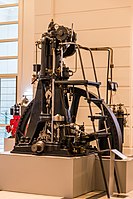
Photo from wikipedia
Abstract The pilot injected fuel masses generally are in the 1–4 mg range for automotive diesel engines and are affected by significant dispersion, which represents an issue for injection control systems.… Click to show full abstract
Abstract The pilot injected fuel masses generally are in the 1–4 mg range for automotive diesel engines and are affected by significant dispersion, which represents an issue for injection control systems. A new methodology has been developed for real-time evaluation of the fuel injected in small injections in diesel engines. The measurement requires the installation of a single pressure transducer on a pipe connecting the injector to the rail. A simple algorithm, which is based on the mass conservation and momentum balance equations, written with respect to a reference frame that is integral with the pressure wave front, has been elaborated to convert the experimental pressure time history into an instantaneous flow rate. The results on the flow-rate through the pipe that connects the injector to the rail are compared with the corresponding numerical outcomes from a 1D model of the fuel injection system. The estimated fuel quantities that enter the injector have been verified to be well correlated with the measured volumes of the fuel injected in small injections. The relation that has been found could be implemented in the engine electronic control unit and employed together with the pressure transducer installed at the inlet of the injector for a more accurate real-time control of both the injected mass and the system high-pressure.
Journal Title: Fuel
Year Published: 2017
Link to full text (if available)
Share on Social Media: Sign Up to like & get
recommendations!